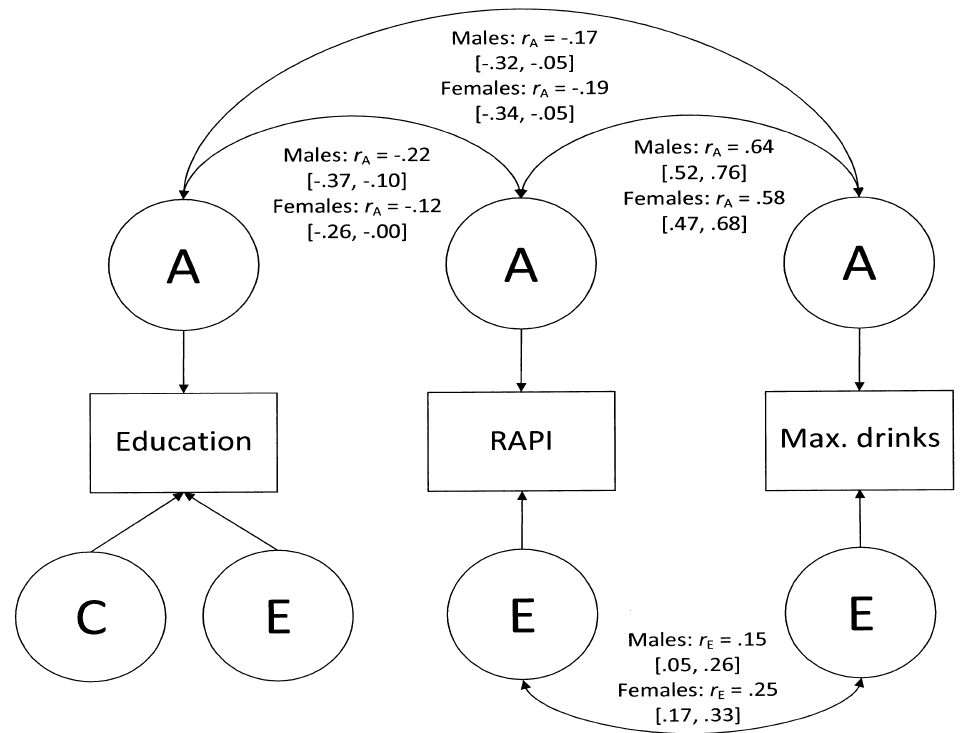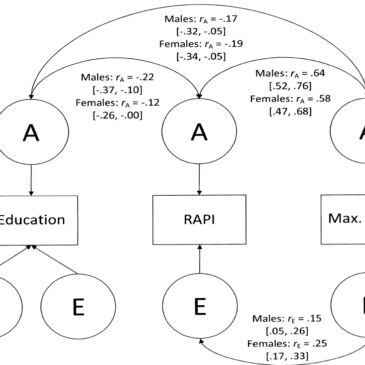Many studies have described an association between academic attainment and alcohol use. For example, Crum et al. (2006) found that drinking among adolescents is associated with more educational problems and Kessler et al. (2005) found that alcohol and substance use disorders are more prevalent among those with lower education levels. It is unclear, however, what role genetic or environmental influences play in this association. This week’s DRAM reviews a study exploring influence of genetic and environmental factors on alcohol use and academic attainment (Latvala, Dick, Tuulio-Henriksson, Suvisaari, Viken, Rose & Kaprio, 2011).
Methods
- 4,858 Finnish twins (1,546 monozygotic [MZ] twins and 3,312 dizygotic [DZ] twins) comprised the sample.
- Participants completed the Rutgers Alcohol Problem Index (RAPI) and reported the maximum number of drinks ever consumed within a 24-hour period, as well as their highest level of education.
- Researchers tested ACE models (GLOSSARY LINK) predicting education, alcohol use problems, and maximum drinks, as well as their correlation, from a combination of three variables derived from twin type (i.e., MZ vs. DZ): genetic influences (A), common environmental influences (C; e.g., family environment), and unique environmental influences (E; e.g., friends).
Results
- Genetic factors (A) and common environmental factors (C), as well as unique environmental factors (E), predicted educational attainment; however, only genetic factors and unique environmental influences predicted the alcohol use outcomes (see Figure).
- Genetic factors (A) were significantly related to the negative association between educational attainment and alcohol use problems, which was small but significant in the full sample (r = -.06 to -.09). Put simply, MZ twins had higher correlations between educational attainment and alcohol use outcomes than DZ twins. This pattern was not found for common (C) or unique environmental (E) influences.

Figure. Schematic of models predicting alcohol use and education attainment (Lavata et al. 2011). Click image to enlarge.
Limitations
- The education system in Finland is very different from that in the United States: schooling is free and mandatory through 9th grade (middle school). Schools are of relatively uniform quality (Latvala et al., 2011). This may limit generalizability to countries such as the US, where income and social status can greatly influence education accessibility and quality Twin studies are limited in their generalizability, given the unique context within which twins develop.
- This study cannot determine causality; we cannot know whether genetic or environmental factors directly influence educational attainment or alcohol use, only their level of association.
Conclusions
The current study suggests that genetic factors (A) influence both educational attainment and alcohol use, as well as their relationship, suggesting that there may be a common genetic underpinning for both these phenotypes. Common environmental influences (C), however, only influenced educational achievement. These results suggest a genetic influence on both educational attainment and alcohol use. Environmental influences play a greater role in educational attainment than alcohol use.
-Daniel Tao
What do you think? Please use the comment link below to provide feedback on this article.
References
Crum, R.M., Juon, H.S., Green, K.M., Robertson, J., Fothergill, K., Ensminger, M. (2006). Educational achievement and early school behavior as predictors of alcohol-use disorders. Journal of Studies on Alcohol, 67, 75-85.
Kessler, R.C., Berglund, P., Demler, O., Jin, R., Merikangas, K.R., Waters, E.E. (2005). Lifetime prevalence and age-of-onset distributions of DSM-IV disoders in the National Comorbidity Survey Replication. Archives of General Psychiatry, 62, 593-602.
Lavata, A., Dick, D.M., Tuulio-Henriksson, A., Suvisaari, J., Viken, R.J., Rose, R.J., Kaprio, J. (2011). Genetic correlation and gene-environment interaction between alcohol problems and educational level in young adulthood. Journal of Studies on Alcohol and Drugs, 72, 210-220.




